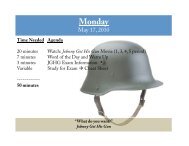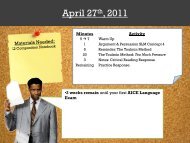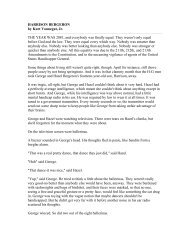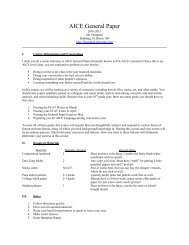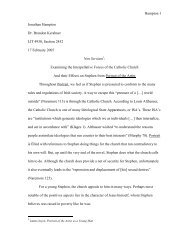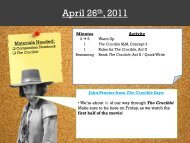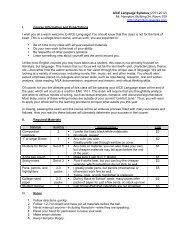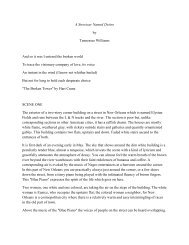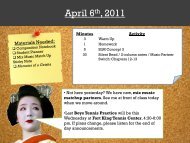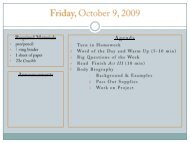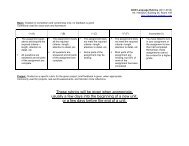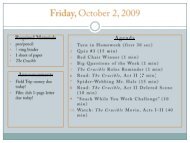Language Analysis
Language Analysis
Language Analysis
You also want an ePaper? Increase the reach of your titles
YUMPU automatically turns print PDFs into web optimized ePapers that Google loves.
May 17 th , 2011<br />
Minutes<br />
5 7<br />
3<br />
10<br />
20 25<br />
Activity<br />
Warm Up<br />
Return to <strong>Language</strong> <strong>Analysis</strong> SLM<br />
Notes from Part A: Mood & Tone, Descriptive<br />
& Figurative <strong>Language</strong>, Frayer Folds<br />
Pairs: Practice with Town Bombing<br />
John Proctor from The Crucible Says:<br />
• Welcome to Day #1 of “Return to <strong>Language</strong><br />
<strong>Analysis</strong>”!<br />
• Did you know that 50% of the students last year<br />
FAILED the language analysis section?
A<br />
S<br />
S<br />
I<br />
G<br />
N<br />
M<br />
E<br />
N<br />
T<br />
Warm Up (5.17.11)<br />
Volume-O-Meter: 0 (Silence)<br />
Time: 5 Minutes<br />
Share-Out: Shoulder Partners / Volunteers<br />
-------------------------------------------------------------------------------<br />
1. Today we return to <strong>Language</strong> <strong>Analysis</strong>, a subject<br />
we covered in detail back in October. Using your<br />
notes and/or memory, list any information you can<br />
remember about language analysis…this includes<br />
tone, mood, descriptive and figurative language, as<br />
well as the structure of your exam.
Transition<br />
Return to<br />
<strong>Language</strong><br />
<strong>Analysis</strong><br />
SLM
S<br />
L<br />
M<br />
Unit Essential Question:<br />
How is what I say different from how I say it?<br />
Concept 1:<br />
Descriptive <strong>Language</strong><br />
1. What is descriptive language?<br />
2. How does descriptive language<br />
effect the tone/mood of a passage?<br />
Vocabulary<br />
Diction, tone, mood,<br />
adjectives/adverbs, nouns/verbs,<br />
imagery<br />
Resources:<br />
Practice passages, The Crucible<br />
Concept 2:<br />
Figurative <strong>Language</strong><br />
3. What is figurative language?<br />
4. How does figurative language<br />
effect the imagery of a passage?<br />
Vocabulary<br />
Similes, metaphors, personification,<br />
hyperbole
S<br />
L<br />
M<br />
Unit Essential Question:<br />
How is what I say different from how I say it?<br />
Concept 3:<br />
Strategies for Use<br />
5. How can a Frayer Fold help me<br />
analyze the language of a passage?<br />
Frayer fold<br />
Vocabulary<br />
Resources:<br />
Practice passages, The Crucible
Transition<br />
Notes
T<br />
A<br />
K<br />
E<br />
N<br />
O<br />
T<br />
E<br />
S<br />
Diction & Imagery<br />
Authors choose to write their stories using SPECIFIC words<br />
and phrases; it uses:<br />
1. Descriptive <strong>Language</strong> and/or<br />
2. Figurative <strong>Language</strong><br />
Imagery = mental picture created by words/phrases
T<br />
A<br />
K<br />
E<br />
N<br />
O<br />
T<br />
E<br />
S<br />
Tone & Mood<br />
Tone: The attitude the author has<br />
towards a certain subject.<br />
Apathy<br />
Sarcastic<br />
Neutral<br />
Pessimistic<br />
Mood: The feeling the reader has<br />
while reading.<br />
Horrifying<br />
Romantic<br />
Sad
T<br />
A<br />
K<br />
E<br />
N<br />
O<br />
T<br />
E<br />
S<br />
Types of Descriptive <strong>Language</strong><br />
1. Nouns:<br />
Person, place, or thing<br />
2. Verbs:<br />
Shoe boot Stiletto heel<br />
Action words<br />
3. Adjectives:<br />
Threw tossed catapulted<br />
Words that modify nouns or pronouns<br />
4. Adverbs:<br />
“The grandmotherly elephant”<br />
Words that modify everything else<br />
(verbs, adverbs, other adjectives)<br />
“He drove slowly”
T<br />
A<br />
K<br />
E<br />
N<br />
O<br />
T<br />
E<br />
S<br />
Types of Figurative <strong>Language</strong><br />
1. Similes:<br />
Comparison using like/as<br />
2. Metaphors:<br />
Life is like a box of chocolates<br />
Does not use like or as<br />
Life is a box of chocolates<br />
3. Personification:<br />
Gives a non-living object human traits<br />
4. Hyperbole:<br />
The grass danced in the breeze<br />
An exaggeration<br />
The line was a million miles long
T<br />
A<br />
K<br />
E<br />
N<br />
O<br />
T<br />
E<br />
S<br />
On <strong>Language</strong> <strong>Analysis</strong> Exam…<br />
Steps<br />
1. Read passage<br />
While reading, write down words/phrases that seem interesting<br />
(descriptive or figurative examples)<br />
2. Explain how these words/phrases effect the passage<br />
Do they effect the tone / mood?<br />
Do they help the reader’s imagery?<br />
3. For Band 1 = 13-15 comments on passage
A<br />
S<br />
S<br />
I<br />
G<br />
N<br />
M<br />
E<br />
N<br />
T<br />
Directions:<br />
Make Frayer Fold<br />
On Sheet of Paper: Follow Hampton’s Instructions<br />
Use Frayer Fold to pick out words / phrases and what you think<br />
they mean!
Frayer Fold Example<br />
Pillowed
A<br />
S<br />
S<br />
I<br />
G<br />
N<br />
M<br />
E<br />
N<br />
T<br />
Directions:<br />
Move into Pairs<br />
Pass out passage (1 per<br />
group)<br />
Read passage<br />
Use Frayer Fold (pick<br />
out 4 words and analyze<br />
those words)<br />
Practice Passage




